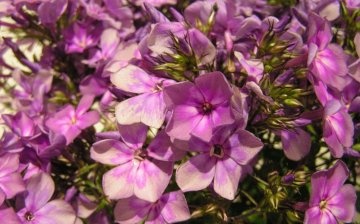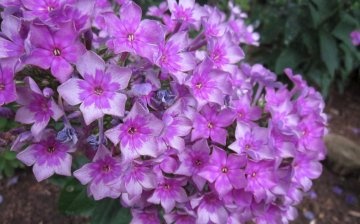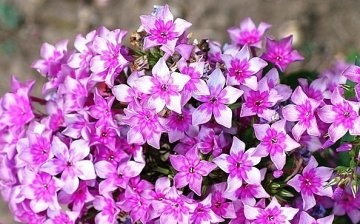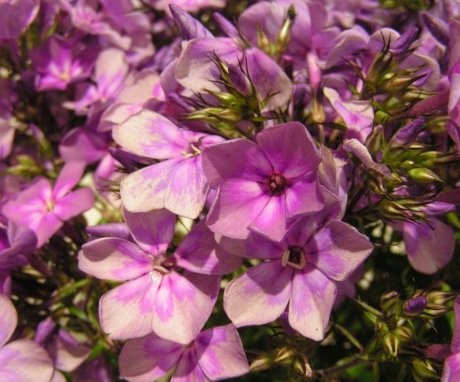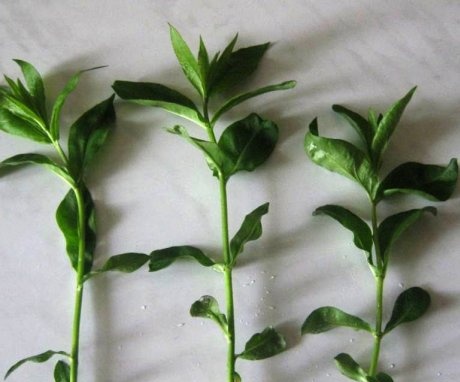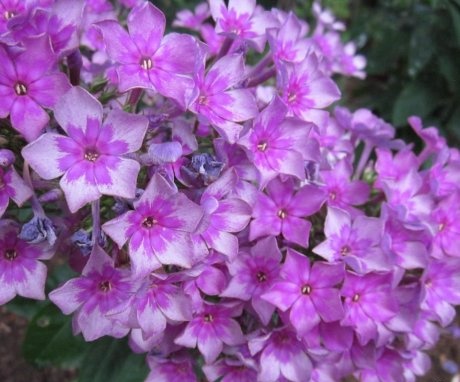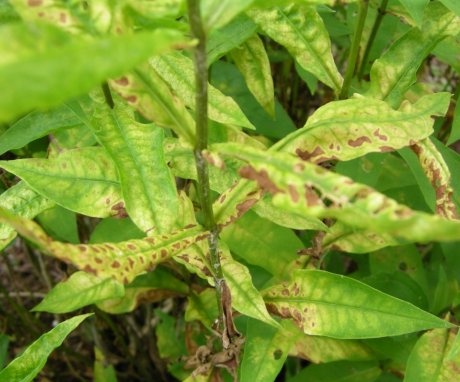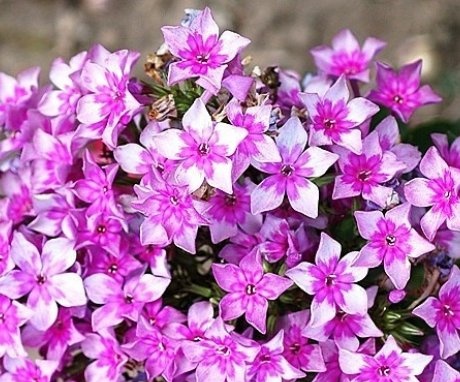Phlox Stargazer: cultivation and application in garden design
From flowering herbaceous plants are popular phloxes... The flower has more than fifty species. Of these, the most common phlox paniculata, which is distinguished by a variety of colors. This type of plant is actively used in the design of the site.
The phlox genus was discovered long ago and got its name due to its bright, like flame, color. Now breeders have bred varieties that are ideal for decorating lush flower beds on the site. Among them, the phlox Stargazer is interesting.
Content:
- External characteristics of the variety
- Breeding methods, rules for planting perennials
- How to properly care for bush phlox
- Diseases and pests of plants, the fight against them
- The use of phlox in the design of the site
External characteristics of the variety
Stargazer refers to tall bush plants. The height of erect stems reaches half a meter. Shoots are densely covered with green lanceolate leaves. By autumn, the stems are partially lignified.
Phlox Stargazer is preferred by flower growers because of the beauty of the plant, the aroma of which will create comfort in the summer garden.
The inflorescences collected in panicles appear on the bushes at the end of May. The flowers are up to one and a half centimeters in diameter and look like stars. In the middle of a light lilac haze of petals, a bright star of purple or pink tones is drawn. The inflorescences are so large that they decorate the flower beds until autumn.
The underground part of the bush is represented by thin fibrous roots. On the root collars, buds are located, from which new shoots develop. This is how the root and shoots grow. If the kidneys are frozen, then there will be no new growths.
Breeding methods, rules for planting perennials
Phlox are propagated in several ways:
- Dividing the bush carried out in early spring or autumn. Having dug up a perennial, they shake off the stems and roots from the ground. Carefully separate parts of the rhizome so that each one has the rudiments of shoots. After separation, the bushes are immediately planted, preventing the roots from drying out. If the roots are dry, then they are dipped into a clay mash.
- Propagated by cuttings by cutting off twigs with two nodules-buds from the bush. One cut goes under the knot, the other is 2-3 centimeters higher. Before planting in the ground, the leaves are removed from the cutting from the bottom, leaving a part at the top. Place the material in boxes with nutrient soil. For cuttings, create greenhouse conditions, covering from direct sunlight. Water the soil in containers 2-3 times a week. The planting result will be visible after two or three weeks. After the appearance of young shoots, phlox is transplanted to a permanent place. You can immediately plant the cuttings in open ground by mulching the phlox with a layer of fallen leaves or peat for the winter.
- Another way of planting phlox is by separating the cuttings with a developed root system from the mother root. Then the bushes are transplanted to another site.
- Seeds are propagated by phlox Stargazer for the winter. Before sowing, select high-quality round-shaped seeds of dark color. The plantings are covered with mulch and snow.In April, seedlings will appear, which are planted when they reach ten centimeters in height.
For planting phloxes, choose an area with wet soil. The flower tolerates both the sun and partial shade. But the bright petals of the Stargazer variety can burn out in the sun. It is better to plant the plant next to shrubs that protect it from the heat and cold wind. But you cannot place them with trees and shrubs with a superficial root system: birch, lilac, poplar.
A novice gardener can also cope with the reproduction and planting of phlox.
The soil for the flower needs loose, with neutral acidity. Phlox bushes grow better on loams, sandy loam soils. Before the planting procedure, the flower garden is dug up, adding humus, peat and a complex of fertilizers. When planting, the root collar is buried three centimeters into the ground.
The distance between flowers is kept at the level of 30-40 centimeters. The optimal planting time for the Stargazer phlox is April or September. Bushes take root well in cloudy weather, planted in the morning or evening. Water the flower beds abundantly for the first two weeks after planting the flowers.
How to properly care for bush phlox?
The plant tolerates even poor care. But to improve the decorative properties of the bush, it is necessary:
- watering the flower under the root without moisture getting on the leaves and flowers
- loosen the soil after heavy rains and heavy irrigation
- apply fertilizers three times: nitrogenous - in early spring, phosphorus and potassium - during budding and flowering, complex - before wintering
- pruning an overgrown bush in autumn
- process fungicidal or insecticidal preparations after complete or partial removal of shoots
- mulch plantings in autumn with a layer of horse manure, peat, fallen leaves
If you properly care for the Stargazer phlox, then the perennial will decorate the garden throughout the spring-summer season.
Diseases and pests of plants, the fight against them
The high moisture content of the soil, which phloxes love so much, is an ideal breeding ground for fungal infections. Hence the disease of flowers:
- Powdery mildew damages the decorativeness of the plant. Affected by a white bloom, the aerial parts of the bush are bent, dry up, the flowers fall off. For the prevention of the disease, the soil in the flower garden is not overfed with nitrogen. Dense plantings of phloxes lead to infections. The disease can be prevented by treating perennials with a 1% solution of soda ash or a product consisting of copper sulfate and laundry soap. On a bucket of water, take twenty-five grams of vitriol and two hundred - soap.
- Septoria is characterized by brown spots on the leaves, which gradually dry out and fall off. Sick plant sprayed Bordeaux liquidby repeating the procedure after ten days. The damaged parts of the phlox are cut off and destroyed.
- During flowering, the plant is affected by phomosis. They recognize the disease by drying and folding the leaves in the lower part of the bush, cracking and breaking off the stems. Infection can be prevented by spraying with Bordeaux liquid solution. During planting, it is impossible to bring manure with mold, sawdust or shavings into the soil during planting.
- Phlox verticillary wilting occurs without visible symptoms. Pathology occurs in perennials growing on acidic soils. Sick bushes are destroyed, and crushed copper sulfate is poured into the pits. Plant phloxes this place is possible only after a year.
Astrologer is distinguished from phlox pests nematodes... These inconspicuous worms lead to the ugliness of flowers, a stop in development. Stems and leaves dry out and become brittle. The nematode spreads with planting material through the soil. Bushes infected with a pest are burned. Ornamental perennials get rid of diseases and pests with preventive measures.
The use of phlox in the design of the site
Due to the duration of flowering of the plant, its vitality, the flower looks great in single plantings in the middle of a green lawn. In groups with other types of phlox, the Stargazer variety is planted, taking into account the combination of colors. Bright petals of inflorescences are combined with paler tones.
You can arrange flowers of all shades of blue, lilac side by side, diluting with a white tone. Combinations in landings look especially interesting. mixborder... Phlox is planted Stargazer next to or against the background of conifers. Bulbous plants are placed on an alpine hill next to phlox: lilies, dahlias.
Flowers fit harmoniously into landscaped gardens, small summer cottages, country-style, retro areas.
To make the phlox of the Stargazer variety look colorful, they think over compositions with a plant, taking into account the style of the garden, the taste of the summer resident. Phlox is distinguished from the most famous and unpretentious herbaceous plants. They will not only decorate the garden, but will also cheer you up with their pleasant light aroma. Among the varieties of paniculate perennial, the phlox Stargazer is interesting in color, structure of the flower.
More information can be found in the video:




